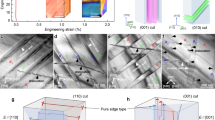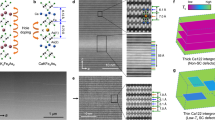Abstract
Crystal lattice defects often degrade device functionality1,2, but engineering these defects may have value in future electronic and magnetic device applications. For example, dislocations—one-dimensional lattice defects with locally distinct atomic-scale structures3,4—exhibit unique and localized electrical properties5,6 and can be used as a template for producing conducting nanowires in insulating crystals7,8,9,10,11. It has also been predicted that spin-polarized current may flow along dislocations in topological insulators12. Although it is expected that the magnetic properties of dislocations will differ from those of the lattice5,13,14, their fundamental characterization at the individual level has received little attention. Here, we demonstrate that dislocations in NiO crystals show unique magnetic properties. Magnetic force microscopy imaging clearly reveals ferromagnetic ordering of individual dislocations in antiferromagnetic NiO, originating from the local non-stoichiometry of the dislocation cores. The ferromagnetic dislocations have high coercivity due to their strong interaction with the surrounding antiferromagnetic bulk phase. Although it has already been reported that nanocrystals of rock-salt NiO show ferromagnetic behaviour15, our study characterizes the ferromagnetic properties of individual lattice defects. We discuss the origin of the unexpected ferromagnetism in terms of the physical properties of the atomic-scale core structures of single dislocations, and demonstrate that it is possible to fabricate stable nanoscale magnetic elements inside crystalline environments composed of these microstructures.
This is a preview of subscription content, access via your institution
Access options
Subscribe to this journal
Receive 12 print issues and online access
$259.00 per year
only $21.58 per issue
Buy this article
- Purchase on Springer Link
- Instant access to full article PDF
Prices may be subject to local taxes which are calculated during checkout




Similar content being viewed by others
References
Hÿtch, M. J., Putaux, J. L. & Penisson, J. M. Measurement of the displacement field of dislocations to 0.03 Å by electron microscopy. Nature 423, 270–273 (2003).
Son, J. et al. Epitaxial SrTiO3 films with electron mobilities exceeding 30,000 cm2/V·s. Nature Mater. 6, 482–484 (2010).
Ikuhara, Y. & Pirouz, P. High resolution transmission electron microscopy studies of metal/ceramics interfaces. Microsc. Res. Tech. 40, 206–241 (1998).
Stoneham, A. M. Theory of Defects in Solids (Clarendon, 1985).
Szot, K., Speier, W., Bihlmayer, G. & Waser, R. Switching the electrical resistance of individual dislocations in single-crystalline SrTiO3 . Nature Mater. 5, 313–320 (2006).
Chu, M. et al. Impact of misfit dislocations on the polarization instability of epitaxial nanostructured ferroelectric perovskites. Nature Mater. 3, 87–90 (2004).
Nakamura, A., Matsunaga, K., Tohma, J., Yamamoto, T. & Ikuhara, Y. Conducting nanowires in insulating ceramics. Nature Mater. 2, 453–456 (2003).
Ikuhara, Y. Nanowire design by dislocation technology. Prog. Mater. Sci. 54, 770–791 (2009).
Tokumoto, Y. et al. Fabrication of electrically conductive nanowires using high-density dislocations in AlN thin films. J. Appl. Phys. 106, 124307 (2009).
Amma, S. et al. Electrical current flow at conductive nanowires formed in GaN thin films by a dislocation template technique. Appl. Phys. Lett. 96, 193109 (2010).
Kioseoglou, J. et al. Screw threading dislocations in AlN: structural and electronic properties of In and O doped material. J. Appl. Phys. 110, 053715 (2011).
Ran, Y., Zhang, Y. & Vishwanath, A. One-dimensional topologically protected modes in topological insulators with lattice dislocations. Nature Phys. 5, 298–303 (2009).
Seeger, A., Rieger, H., Trauble, H. & Kronmuller, H. Effect of lattice defects on magnetization curve of ferromagnets. J. Appl. Phys. 35, 740–748 (1964).
Nakagawa, K., Maeda, K. & Takuechi, S. Plastic deformation of CdTe single crystals II. Photoplastic effect of II–VI compounds. J. Phys. Soc. Jpn 50, 3040–3046 (1981).
Bi, H., Li, S., Zhang, Y. & Du, Y. Ferromagnetic-like behavior of ultrafine NiO nanocrystallites. J. Magn. Magn. Mater. 277, 363–367 (2004).
Haberle, T. et al. Towards quantitative magnetic force microscopy: theory and experiment. New J. Phys. 14, 043044 (2012).
Sebastian, A., Salapaka, M. V., Chen, D. J. & Cleveland, J. P. Harmonic and power balance tools for tapping-mode atomic force microscope. J. Appl. Phys. 89, 6473–6480 (2001).
Maruyama, S., Gervais, A. & Philibert, A. Transmission electron microscopy on nickel oxide single crystals deformed at room temperature. J. Mater. Sci. 17, 2384–2390 (1982).
Ohta, J., Suzuki, K. & Suzuki, T. High-resolution electron microscopy of dislocations of MgO. J. Mater. Res. 9, 2953–2958 (1994).
Foitzik, A., Haasen, P. & Skrotzki, W. High resolution TEM of dissociated dislocations in PbS. Phil. Mag. A 64, 29–37 (1991).
Wang, Z. C., Tsukimoto, S., Saito, M. & Ikuhara, Y. Individual charge-trapping dislocations in an ionic insulator. Appl. Phys. Lett. 95, 184101 (2009).
Reinert, F. et al. Electron and hole doping in NiO. Z. Phys. B 97, 83–93 (1995).
Koyama, Y., Mizoguchi, T., Ikeno, H. & Tanaka, I. Electronic structure of lithium nickel oxide by electron energy loss spectroscopy. J. Phys. Chem. B 109, 10749–10755 (2005).
Shimomura, Y., Kojima, M. & Saito, S. Crystal structure of ferromagnetic nickel oxide. J. Phys. Soc. Jpn 11, 1136–1146 (1956).
Nogues, J. et al. Exchange bias in nanostructures. Phys. Rep. 422, 65–117 (2005).
Wei, M. et al. Room temperature ferromagnetism in bulk Mn-Doped Cu2O. Appl. Phys. Lett. 86, 072514 (2005).
Lin, Y-H., Zhan, B., Nan, C-W., Zhao, R. & Xu, X. Ferromagnetism in antiferromagnetic NiO-based thin film. J. Appl. Phys. 110, 043921 (2011).
Zippel, J. et al. Defect-induced ferromagnetism in undoped and Mn-doped zirconia thin films. Phys. Rev. B 82, 125209 (2010).
Wollschläger, J. et al. Stoichiometry and morphology of MgO films grown reactively on Ag(100). Appl. Surf. Sci. 142, 129–134 (1999).
Joshi, U. S., Takahashi, R., Matsumoto, Y. & Koinuma, H. Structure of NiO and Li-doped NiO single crystalline thin layers with atomically flat surface. Thin Solid Films 486, 214–217 (2005).
Acknowledgements
This study was supported in part by the Grant-in-Aid for Scientific Research from the Japan Society for the Promotion of Science (JSPS) and the Ministry of Education, Culture, Sports and Technology (MEXT). I.S. and S.K. were supported as JSPS research fellows. N.S. acknowledges support from JST-PRESTO and JSPS KAKENHI Grant number 23686093. This work was conducted in the research Hub for Advanced Nano Characterization, the University of Tokyo, supported by MEXT. Part of this work was performed using the facilities of the Cryogenic Research Center at the University of Tokyo. Calculations were conducted on supercomputers at the ISSP, the University of Tokyo.
Author information
Authors and Affiliations
Contributions
I.S. carried out the experiments and wrote the paper. N.S. designed the experiments and wrote the paper. Z.W. carried out the DFT calculations. T.Y. designed and conducted the experiments. S.K. supported and advised the experiments. Y.I. discussed the results and directed the entire study. All authors read and commented on the manuscript.
Corresponding author
Ethics declarations
Competing interests
The authors declare no competing financial interests.
Supplementary information
Supplementary information
Supplementary information (PDF 914 kb)
Rights and permissions
About this article
Cite this article
Sugiyama, I., Shibata, N., Wang, Z. et al. Ferromagnetic dislocations in antiferromagnetic NiO. Nature Nanotech 8, 266–270 (2013). https://doi.org/10.1038/nnano.2013.45
Received:
Accepted:
Published:
Issue Date:
DOI: https://doi.org/10.1038/nnano.2013.45
This article is cited by
-
Field-free spin-orbit switching of perpendicular magnetization enabled by dislocation-induced in-plane symmetry breaking
Nature Communications (2023)
-
Topotactically transformable antiphase boundaries with enhanced ionic conductivity
Nature Communications (2023)
-
Dislocation interactions during plastic relaxation of epitaxial colloidal crystals
Nature Communications (2023)
-
Unravelling the role of cationic Ni2+ vacancies and Ni3+ ions in non-stoichiometric NiO: breakdown of anti-ferromagnetic ordering and large exchange bias
Journal of Materials Science (2023)
-
Enhanced superconductivity and ferroelectric quantum criticality in plastically deformed strontium titanate
Nature Materials (2022)



